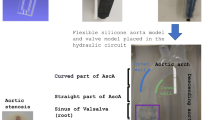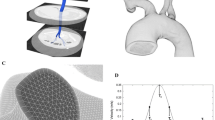Abstract
Pulsatile aqueous glycerol solution flows in the models simulating normal and stenosed human aortic arches are measured by means of particle image velocimetry. Three transparent models were used: normal, 25% stenosed, and 50% stenosed aortic arches. The Womersley parameter, Dean number, and time-averaged Reynolds number are 17.31, 725, and 1,081, respectively. The Reynolds numbers based on the peak velocities of the normal, 25% stenosed, and 50% stenosed aortic arches are 2,484, 3,456, and 3,931, respectively. The study presents the temporal/spatial evolution processes of the flow pattern, velocity distribution, and wall-shear stress during the systolic and diastolic phases. It is found that the flow pattern evolving in the central plane of normal and stenosed aortic arches exhibits (1) a separation bubble around the inner arch, (2) a recirculation vortex around the outer arch wall upstream of the junction of the brachiocephalic artery, (3) an accelerated main stream around the outer arch wall near the junctions of the left carotid and the left subclavian arteries, and (4) the vortices around the entrances of the three main branches. The study identifies and discusses the reasons for the flow physics’ contribution to the formation of these features. The oscillating wall-shear stress distributions are closely related to the featured flow structures. On the outer wall of normal and slightly stenosed aortas, large wall-shear stresses appear in the regions upstream of the junction of the brachiocephalic artery as well as the corner near the junctions of the left carotid artery and the left subclavian artery. On the inner wall, the largest wall-shear stress appears in the region where the boundary layer separates.













Similar content being viewed by others
Abbreviations
- A :
-
Cross-section area of aorta model
- B :
-
Blockage ratio (=[(E 2−R i )/D i ] × 100%)
- De :
-
Dean number (=Re(r i /R c )0.5)
- D i :
-
Inner diameter of aorta model, 25 mm
- D o :
-
Outer diameter of aorta model, 28 mm
- E 1 :
-
Short radius of ellipse for description of plaque
- E 2 :
-
Long radius of ellipse for description of plaque
- F :
-
Frequency of flow pulsating
- H :
-
Length of straight sections of aorta model, 300 mm
- P gage :
-
Gage pressure of pulsatile flow at upstream region
- Q ave :
-
Time-averaged volumetric flow rate of pulsatile flow
- Re ave :
-
Reynolds number based on average velocity (=U ave D i /ν)
- Repeak :
-
Reynolds number based on peak velocity of cardiac cycle
- R i :
-
Radius of curvature of inner arch wall, 13.5 mm
- r i :
-
Inner radius of aorta model cross section, 12.5 mm
- R c :
-
Radius of curvature of centerline of arch, 27.5 mm
- R o :
-
Radius of curvature of outer arch wall, 41.5 mm
- r o :
-
Outer radius of aorta model cross section, 14 mm
- T :
-
Pulsating period of flow
- t :
-
Time evolution
- t* :
-
Non-dimensional time (=t/T)
- U ave :
-
Time-averaged flow velocity of pulsatile flow (=Q/A)
- u :
-
Axial velocity
- u τ :
-
Friction velocity (=(τ/ρ)1/2)
- u+:
-
Non-dimensional axial velocity (=u/u τ )
- y :
-
Coordinate normal to and away from wall
- y+:
-
Non-dimensional distance from wall (=u τ y/ν)
- α :
-
Womersley parameter (=r i (f/ν)0.5)
- τ:
-
Wall-shear stress
- ρ :
-
Density of working fluid (=1.13 g/cm3 at 37°C)
- ν :
-
Kinematic viscosity of working fluid (=3.93 × 10−6 m2/s at 37°C)
References
Adams EW, Johnston JP (1988) Flow structure in the near-wall zone of a turbulent separated flow. AIAA J 26(8):932–939
Adams GA, Brown SJ, McIntire LV, Eskin SG, Martin RR (1983) Kinetics of platelet adhesion and thrombus growth. Blood 62:69–74
Chandran KB, Cabell GN, Khalighi B, Chen C-J (1984) Pulsatile flow past aortic valve bioprostheses in a model human aorta. J Biomech 17(8):609–619
Chandran KB, Khalighi B, Chen C-J (1985a) Experimental study of physiological pulsatile flow past valve prostheses in a model of human aorta—I. Caged ball valves. J Biomech 18(10):763–772
Chandran KB, Khalighi B, Chen C-J (1985b) Experimental study of physiological pulsatile flow past valve prostheses in a model of human aorta—II. Tilting disc valves and the effect of orientation. J Biomech 18(10):773–780
Clauser FH (1954) Turbulent boundary layers in adverse pressure gradient. J Aeronaut Sci 21(2):91–108
Davis PF (1995) Flow-medicated endothelial mechanotransduction. Physiol Rev 75:519–560
Dean WR (1927) Note on the motion of fluid in a curved pipe. Phil Mag 20:208–223
DeBakey ME, McCollum CH, Grawford ES, Morris GC, Howell J, Noon GP, Lawrie G (1982) Dissection and dissecting aneurysms of the aorta: twenty-year follow-up of five hundred twenty-seven patients treated surgically. Surgery 92(6):1118–1134
DeBakey ME, Lawrie GM, Glaeser DH (1985) Patterns of atherosclerosis and their surgical significance. Ann Surg 201(2):115–131
Helmlinger G, Berk RV, Schrech S, Nerem RM (1991) Effects of pulsatile flow on cultured vascular endothelial cell morphology. J Biomech Eng 113:123–134
Huang PG, Bradshow P (1995) Law of the wall for turbulent flows in pressure gradients. AIAA J 33(4):624–632
Huang RF, Lin KH, Yeh C-N (2009) In-cylinder tumble flows and performance of a motorcycle engine with circular and elliptic intake ports. Exp Fluids 46(1):165–179
Kays WM, Crawford ME (1980) Convective heat and mass transfer. McGraw-Hill, New York
Keane RD, Adrian RJ (1990) Optimization of particle image velocimeters Part I: double pulsed systems. Meas Sci Technol 1(6):1202–1215
Keane RD, Adrian RJ (1992) Theory of cross-correlation analysis of PIV images. Appl Sci Res 49(3):191–215
Khalighi B, Chandran KB, Chen C-J (1983a) Steady flow development past valve prostheses in a model human aorta—I. Centrally occluding valves. J Biomech 16(12):1003–1011
Khalighi B, Chandran KB, Chen C-J (1983b) Steady flow development past valve prosthese in a model human aorta—II. Tilting disc valves. J Biomech 16(12):1013–1018
Kim T, Cheer AY, Dwyer HA (2004) A simulated dye method for flow visualization with a computational model for blood flow. J Biomech 37(12):1125–1136
Ku DN, Giddens DP, Zarins CK, Glagov S (1985) Pulsatile flow and atherosclerosis in the human carotid bifurcation: positive correlation between plaque location and low and oscillating shear stress. Arteriosclerosis 5(3):293–301
Lei M, Kleinstreuer C, Truskey GA (1995) Numerical investigation and prediction of atherogenic sites in branching arteries. J Biomech Eng 117(8):350–357
Malek AM, Alper SL, Izumo S (1999) Hemodynamic shear stress and its role in atherosclerosis. J Am Med Assoc 282:2035–2042
Nerem RM (1992) Vascular fluid mechanics, the arterial wall and atherosclerosis. J Biomech Eng 114(8):274–282
Nerem RM, Seed WA (1972) An in vivo study of aortic flow distributions. Cardiovasc Res 6:1–14
Pei Z-H, Xi B-S, Hwang HC (1985) Wall shear stress distribution in a model human aortic arch: assessment by an electrochemical technique. J Biomech 18(9):645–656
Rodkiewicz CM, Kalita W, Kennedy JS, Pelot R (1985) On the flow field distributions due to the aortic arch twist. J Biomech 18(10):781–787
Rohsenow WM, Choi HY (1961) Heat, mass and momentum transfer. Prentice-Hall, Englewood Cliffs
Shahcheraghi N, Dwyer HA, Cheer AY, Barakat AI, Rutaganira T (2002) Unsteady and three-dimensional simulation of blood flow in the human aortic arch. J Biomech Eng 124(8):378–387
Simpson RL, Chew Y–T, Shivaprasad BG (1981) The structure of a separating turbulent boundary layer. J Fluid Mech 113(4):23–51
Singh MP, Sinha PC, Aggarwal M (1978) Flow in the entrance of the aorta. J Fluid Mech 87(1):97–120
Tennekes H, Lumley JL (1972) A first course in turbulence. MIT Press, Cambridge
Yearwood TL, Chandran KB (1980) Experimental investigation of steady flow through a model of the human aortic arch. J Biomech 13(4):1075–1088
Yearwood TL, Chandran KB (1984) Physiological pulsatile flow experiments in a model of the human aortic arch. J Biomech 15(9):683–704
Author information
Authors and Affiliations
Corresponding author
Rights and permissions
About this article
Cite this article
Huang, R.F., Yang, TF. & Lan, YK. Pulsatile flows and wall-shear stresses in models simulating normal and stenosed aortic arches. Exp Fluids 48, 497–508 (2010). https://doi.org/10.1007/s00348-009-0754-y
Received:
Revised:
Accepted:
Published:
Issue Date:
DOI: https://doi.org/10.1007/s00348-009-0754-y




